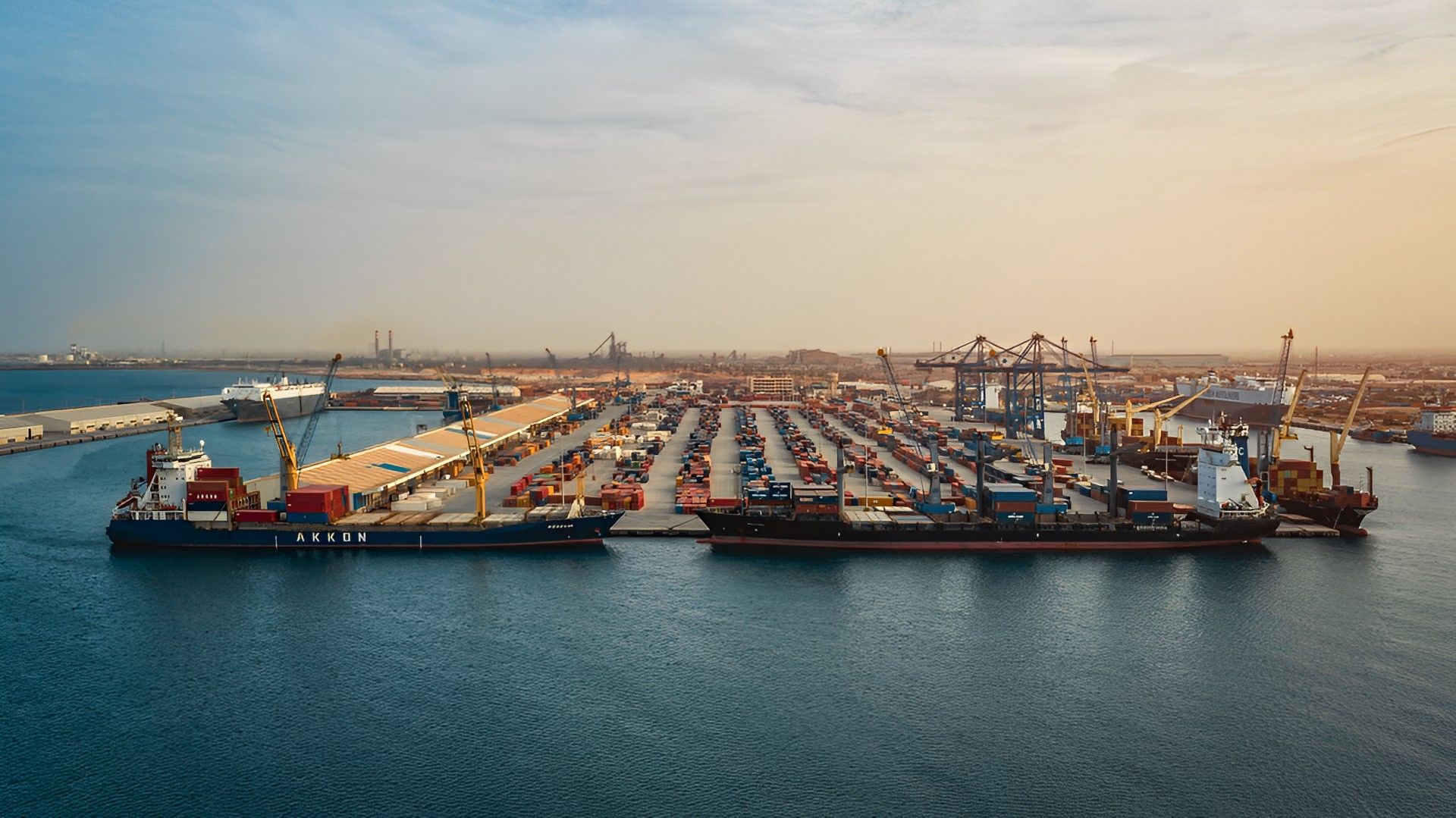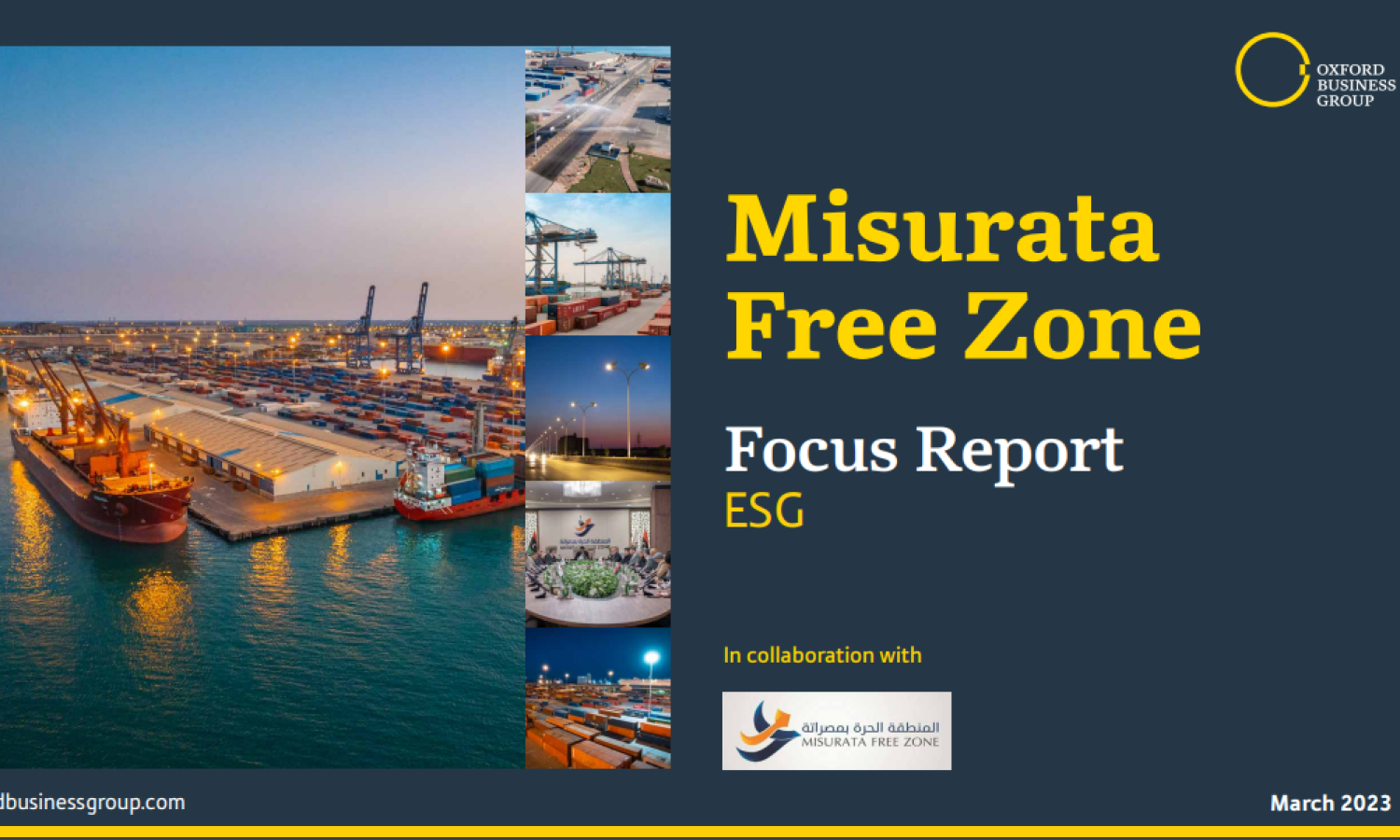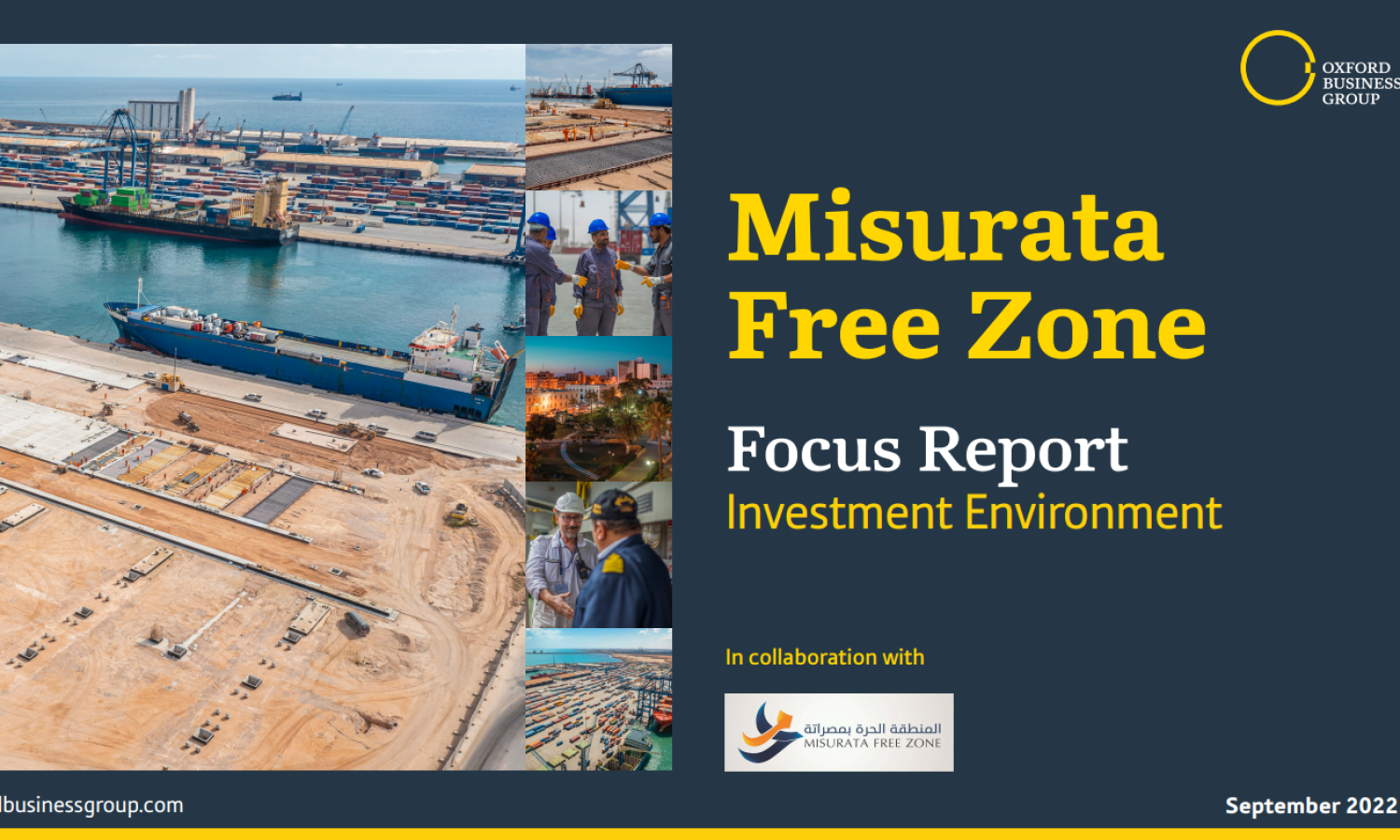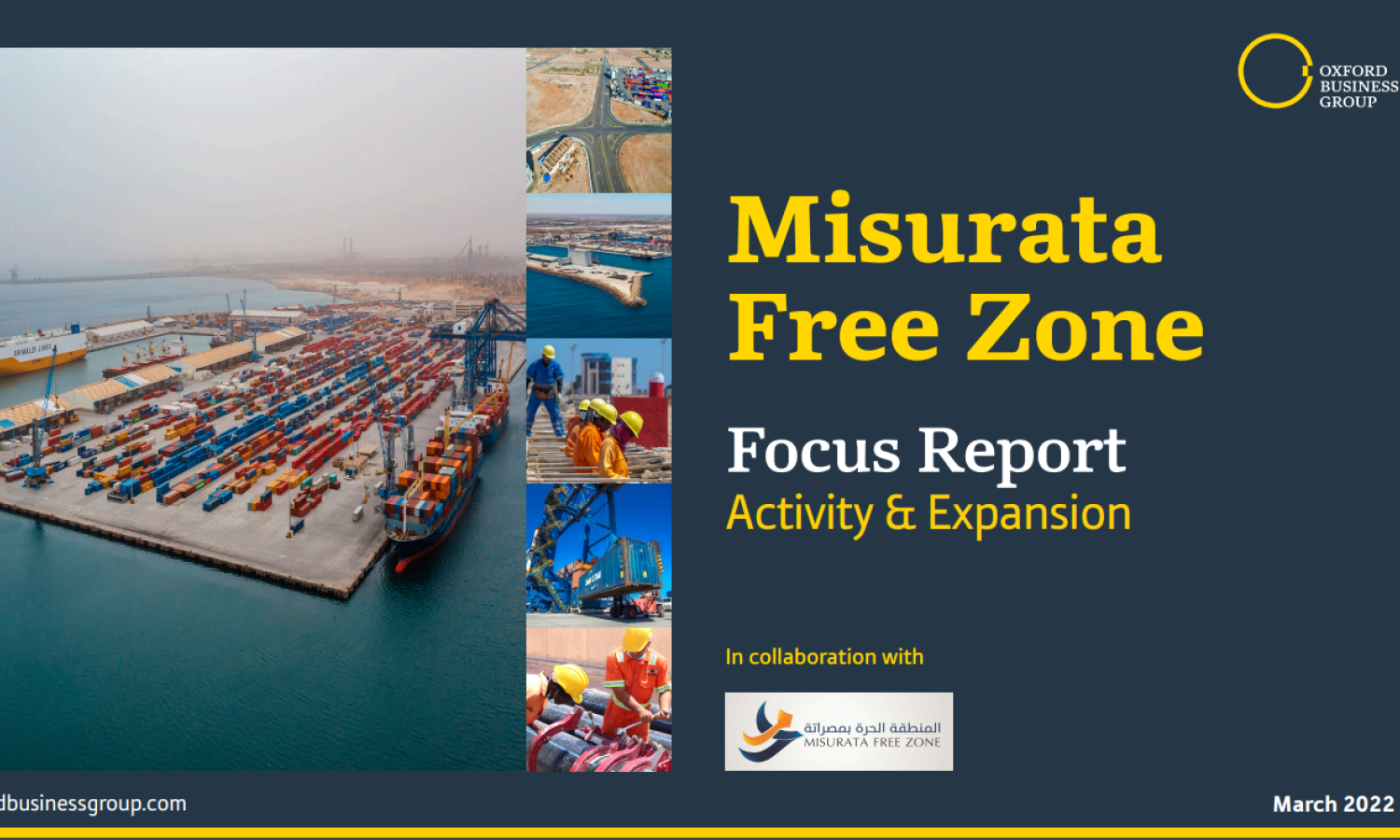
Invest in Libya
Libya offers a business-friendly environment for expansion, trade, and investment, standing as North Africa’s prime investment hub with strong property rights and full tax and customs exemptions for foreign investors.
Libya’s Free Market Transition
Emerging from nearly five decades of economic isolation, Libya is now on a trajectory towards integrating into the global capitalist arena. This transition has been catalysed by a transformative ceasefire accord in 2020, marking a period of economic recovery for the nation. Further bolstering this recovery, the formation of the Government of National Unity in 2021 has enhanced security stability, while fostering stronger institutional synergies between the Eastern and Western regions, aligning with the nation’s overarching market integration objectives.
Key metrics underscore this positive trajectory: there has been an 80% reduction in conflict-related incidents and a 95% reduction in casualties from the medians of 2014-2021, indicating a period of stabilization and growth. Moreover, a resurgence in hydrocarbon prices has facilitated a transition from a 64.1% GDP deficit in 2020 to a 10.6% surplus in 2021. Looking ahead, the IMF projects Libya’s foreign reserves to reach 85 billion USD before 2024. It also forecasts a substantial 17.9% growth in Libya’s GDP for 2023, marking a notable stride in economic progress within the MENA region, especially compared to its GDP growth of 177% in 2021.
This evolving economic landscape unveils an investment opportunity both maximizing capital allocation and contributing to a sustainable and equitable socio-economic paradigm, aligning with broader objectives of societal progress and sustainable development. This presents a compelling proposition for investors seeking a multifaceted value engagement in North Africa’s burgeoning market.
Moreover, historically, foreign investments in the nation were mainly constrained towards the oil sector through sovereign contracts, showcasing Libya’s traditional engagement with Foreign Direct Investment (FDI). The transformative shift however began in the 1990s, and a pivotal moment arrived with the Law No. 9 of the year 2010 regarding Promotion of Foreign & Domestic Investment. Although instituted before the 2011 revolution, this law stands firm today, offering a suite of benefits and incentives to prospective foreign investors:
- Tax Benefits: Exemptions from customs duties on equipment, a five-year moratorium on income tax, and tax relief on reinvested profits.
- Operational Incentives: Permission to transfer net profits overseas, balance out losses in subsequent years, import vital goods, and resort to foreign labour when local talent is unavailable.
- Sectoral Opportunities: Opportunities to establish in sectors like oil exploration, telecommunications, and more, although there’s an emphasis on local employment, with a requirement to hire 30% Libyan nationals and ensure their training.
- Land & Ownership: While foreign investors can’t own land, they can lease real estate temporarily. However, certain strategic industries, especially the upstream oil and gas sector, mandate a partnership with a Libyan entity that retains the majority stake.
Invest in Libya with Additional Privileges and Exemptions
Under the provisions of Law No. 9 from the year 2010, the Libyan Executive also possesses the capability and flexibility to reassess established regulations and rule of law, particularly when a proposed initiative aligns with or catalyzes:
- Regional Development
- Advancement of Food Security
- Augmentation of Energy or Water Resources
- Enhanced Environmental Conservation
Upon successful alignment with these pivotal areas, there exists a possibility to secure additional privileges or exemptions, subject to the endorsement of the executive branch. This arrangement underscores the Libyan administration’s commitment to nurturing projects that resonate with national development and sustainability objectives.
Beyond the aforementioned points, the Libyan regulatory architecture has also paved the way for enhanced trade and investment via the inception of Free Trade Zones (FTZ). Central to this evolution is the Libyan Law Number 495, instituted in 2000 and later refined by its amendment under Law Number 32 of 2006. This legal instrument laid the foundation for the establishment of the Misrata Free Trade Zone (MFZ).
Governance of the MFZ is entrusted to the Libya Free Trade Zone Board, an institution sculpted by Law Number 168 of 2006. This regulatory body ensures that the MFZ operates within its designated mandates. Critically, the MFZ is conferred with financial and administrative autonomy, albeit within the purview of the overarching Libyan legal framework. This autonomy empowers the MFZ to legislate specifically tailored policies, provided they do not contravene national laws.
The Misrata Free Zone offers a compelling proposition for foreign entities, including:
- 0% Personal Income Tax
- 0% Corporate Tax
- 0% Value Added Tax
- 0% Custom Duties
- Complete waiver on any other governmental fiscal obligations
Given the above financial incentives, the Misrata Free Zone emerges as a premier hub for international corporations aiming to mark their presence in the Libyan market.
In summary, while Libya’s markets present lucrative potential, successful navigation demands adept manoeuvring through its intricate economic terrain. The Euro-Libyan Trade Center serves as a key informational resource in this context, maintaining robust connections with essential local institutions and producing insights aligned with overarching investment strategies.
Relevant Regulatory Legislation
The primary legal provision encouraging overseas investment is the Investment Law of 2010. Enacted before the 2011 revolution, it reduced many Foreign Direct Investment barriers and set forth various encouragements to invigorate private investment. No major investment-related legislation has been implemented since. Presently, there are no pandemic or green initiatives that significantly affect the investment atmosphere.
Misrata Free Zone: A Leading Business Destination
The Misrata Free Zone (MFZ) represents a critical nexus in Libya’s economic landscape, currently facilitating indirect employment for over 40,000 individuals. With a current handling of over 350,000 containers annually and a registration of over 500 corporate entities, MFZ stands as Libya’s premier business conduit. The distinct advantages encompassing tax exemptions, customs duties abatement, and assured protection against government fund requisition underscore its significance.
Geographical and Economic Significance:
Positioned in Libya’s third-largest urban centre, MFZ provides a plethora of strategic business incentives:
- 0% Personal or Corporate Income Tax
- 0% Customs Duties or Import/Export Taxes
- 0% Value-Added Tax
- 100% Capital and Profit Repatriation Allowance
- Open policy on Labour Recruitment without constraints
- Reliable and Economically Priced Power Supply
- Possibility of Transferring Ownership
- No Restrictions on Cargo Traffic
In addition, the zone offers competitively priced land leases, currently set at $2.50 per sq metre for the commercial and service sectors. Industrial entities can avail the rates at $1.50 per sq metre annually. The licensing procedures for businesses are streamlined and competitive, with an operational minimum deposit set at $100,000 per entity. Such advantageous parameters have magnetized global industry leaders to the zone, notably automotive pioneers like Toyota and Nissan, the construction conglomerate Albayrak Group from Turkey, Malta’s energy player Medserv Energy, and domestically, Libya’s Brega Petroleum Marketing Company. Consequently, MFZ has crystallized as Libya’s epicentre for trade and foreign investment.
Strategic Position in the Libyan Market:
Misrata, the host city of MFZ, is presently acknowledged as Libya’s most politically stable and secure enclave. This stability propels it as a coveted destination for business establishments and expansions.
Engagement and Collaboration:
The Euro-Libyan Trade Center, as an emissary of the MFZ, is primed to deliver comprehensive insights about the zone. Our services span detailed knowledge dissemination about business advantages, tax reliefs, infrastructural backing, and the zone’s logistical superiority.
For a deeper understanding and tailored guidance, your correspondence with us would be highly valued.

Oxford Business Group’s Focus Reports on MFZ
Oxford Business Group (OBG) stands as a premier global research, publishing, and consultancy firm, specializing in economic insights across the Middle East, Africa, Asia, and Latin America. OBG has undertaken a comprehensive four-part analysis, spotlighting the Misrata Free Zone’s (MFZ) prominence as a leading African transport and logistics nexus, further delving into contemporary advancements in infrastructure and economic progression.
Doing Business in Libya: FAQs
Presented below are the frequently posed inquiries that aim to address and dispel any uncertainties you might harbor regarding conducting business in Libya.
Economy
What is the Real GDP of Libya?
Libya’s Real GDP (purchasing power parity) in 2021 was $147.942 billion. This represents a recovery from the downturn experienced in 2020 when the GDP was $112.612 billion. In 2019, the GDP was $148.037 billion, indicating the impact of global events on the economy.
What is the per capita Real GDP in Libya?
In 2021, this figure was estimated to be $22,000 in Libya, showing resilience in the face of the challenges faced during the preceding years when the GDP per capita dipped to $16,900 in 2020 from $22,500 in 2019.
How does Libya perform in terms of foreign exchange and gold reserves?
As of December 2021, Libya has reserves of foreign exchange and gold worth $82.262 billion. Therefore, Libya had a per capita value of foreign exchange and gold reserves of approximately $11,346.13.
What are the primary industries in Libya?
Libya’s economy is heavily reliant on its petroleum and petrochemical industries. Other significant sectors include aluminum, iron and steel, food processing, textiles, handicrafts, and cement.
Who are Libya’s primary export and import partners?
Libya’s major export partners include Italy, China, Germany, Spain, United Arab Emirates, France, and the United States. Its primary import partners are China, Turkey, Italy, United Arab Emirates, and Egypt.
What are Libya’s main export and import commodities?
Libya’s primary exports are crude petroleum, natural gas, refined petroleum, scrap iron, and gold. Its imports mainly include refined petroleum, cars, broadcasting equipment, cigarettes, and jewelry.
What agricultural products are commonly produced in Libya?
Libya produces a variety of agricultural products including potatoes, watermelons, tomatoes, onions, dates, lemons, olives, wheat, poultry, and various other vegetables.
What is the unemployment rate in Libya?
The unemployment rate in Libya was 19.58% in 2021, which was a marginal decrease from 20.07% in 2020. Moreover, public wages now represent over 60% of the country’s expenditures.
What is the youth unemployment rate in Libya?
The youth unemployment rate in Libya is remarkably high, with a total of 50.5% of individuals aged 15-24 being unemployed. The rate is notably higher for females at 73.8% compared to males at 41.4%.
Which Businesses are the Best to Start in Libya?
Our understanding of the Libyan economy indicates that Libya is in need of economic development, not liquid economic resources. Contrary to prevailing misconceptions, the Libyan economy exhibits a significant level of financial liquidity – readily available for investment opportunities. Therefore, maximising productivity is of paramount importance to the economy, as it facilitates optimal utilisation of available resources.
In order to enter the Libyan market successfully, we recommend foreign companies to capitalise on their “know-how” as well as their intellectual property when seeking to do business in Libya. Moreover, there is an easy availability of Libyan capitalist partners in the public and private sectors, as evidenced by the large-scale projects that are currently underway – further supporting such market entry.
Is Libya a Safe Place for Business?
Examining the business safety of Libya calls for a nuanced understanding of the country’s vast geographical scale, which spans an area six times greater than that of England. Ordinarily, it is plausible for companies to safely establish and maintain operations in Libya if their activities amplify the nation’s economic development. The converging goals of international businesses, Libyan entrepreneurial counterparts, and the local citizenry can cultivate a safe environment ripe for mutual gains.
However, the sheer breadth of the Libyan territory poses certain challenges when attempting to generalize about business operations. It is, therefore, essential to undertake a detailed evaluation of each business proposal or project independently, ensuring an effective alignment with the specific conditions prevalent in the area of operation.
In essence, while Libya can provide fertile ground for successful business operations, one must take into account the diverse realities within its borders and approach each venture with a carefully tailored strategy.
What is Libya’s Status in both multilateral and bilateral Free Trade Agreements (FTAs)?
Libya is part of three multilateral FTAs: the Greater Arab Free Trade Area (GAFTA), the Arab Maghreb Union (AMU), and the African Continental Free Trade Area (AFCFTA), which remains unratified. Bilaterally, Libya has FTAs with Morocco and Jordan.
Which countries has Libya entered into Double Taxation Treaties (DTTs) with?
Libya has, as of November 2023, enacted 10 Double Taxation Treaties with Algeria, Belarus, Egypt, India, Italy, Kuwait, Malta, Pakistan, Singapore, Sudan, Saudi Arabia, Tunisia, and the United Kingdom.
How can foreign companies be structured?
Establishing a commercial entity in Libya entails navigating complex registration procedures, primarily coordinated by the Ministry of Economy and Trade (MET). It is important to note that Libya does not currently provide an online platform for the registration of new businesses.
Various options are available to companies in terms of their structural setup, each carrying distinct registration requirements. Universal mandates include the procurement of a Commercial Register certificate, alignment with the Chamber of Commerce, and adherence to tax and labor department regulations, in addition to obtaining an operational license. For businesses seeking to engage in import activities, a statistical code becomes crucial, while companies aiming to secure letters of credit within Libyan borders are required to procure a Central Bank code.
In the context of establishing a presence in Libya, foreign entities have multiple structural options at their disposal:
- Representative Office
- Branch Office
- Limited Liability Company
- Joint Stock Company
- Investment Law Company
- Free Zone Branch Office
- Free Zone Company
The mentioned structures provide substantial adaptability, addressing distinct business requirements and objectives. Enhanced by the 2010 Investment Law, this flexibility allows foreign entities to tailor their Libyan operations almost according to their preferred organizational design.
Where can I find Libyan Legislation?
As of November 2023, Libyan Law Society is the largest source of legislation in the nation. All Libyan legislation is collected, organized, classified, and presented electronically by this civil society institution devoted to legal affairs.
What is the state of the Legal System and Judicial Independence in Libya?
As of November 2023, the Libyan legal landscape is currently governed by the 2011 Constitutional Declaration, which serves in an interim capacity as the nation’s constitution. Within this legal framework, Islam is expressly recognized as the state religion, and Sharia law is identified as the foundational source of legislation.
A closer examination of the Libyan Civil Code reveals an opening title outlining the overall dispositions regarding law, including sources of law, its applications, and general dispositions about legal definitions of persons, alongside the categorization of items and properties.
The structure of the Code comprises two primary sections, each containing two books. The first section, focused on obligations or personal rights, incorporates Book I (General Obligations) and Book II (Specific Contracts). The second section, titled “Real Rights,” includes Books III (Principal Real Rights) and Book IV (Accessory Real Rights).
In situations where a legal stipulation is absent, the Civil Code calls for courts to rule “in accordance with the principles of Islamic law.” If Islamic law fails to provide guidance on a matter, the Code instructs courts to refer to the “prevailing custom.” In the absence of a relevant custom, the courts are directed to apply “the principles of natural law and the rules of equity.”
The legal creation of a contract, according to Article 89 of the Code, is recognized at the moment two parties exchange corresponding intentions. This formation, however, remains subject to any distinctive formalities required by law.
Regarding the judiciary, the Libyan court system operates on three levels: the courts of first instance, the appellate courts, and the Supreme Court, which is the ultimate appellate level.
What are the current standings on expropriation and compensation in Libya?
Under Libya’s 2010 Investment Law, Article 23 provides a robust safeguard against actions that could potentially infringe upon property rights, such as nationalization, expropriation, forcible seizure, confiscation, imposition of receivership, freezing of assets, or any similar procedures. This protection is granted except when justified by a law or court decision. Furthermore, in the event such proceedings occur, the law stipulates the necessity for fair and equitable compensation.
These safeguards are further reinforced by Article 43 of Executive Regulation No. 449 of 2010, which complements the provisions of the Investment Law by underscoring the rights of property holders against unjustified interference.
Prior to the passage of the Investment Law, Libya had already been witnessing a decline in the practice of state expropriation of private property, including that of foreign-owned companies, particularly prevalent in the 1980s. The enforcement of the 2010 Investment Law and subsequent regulations only strengthened this trend. It’s significant to highlight that, since the enactment of the law, there have been no recorded instances of nationalizations or expropriations.
How is the dispute settlement process structured in Libya?
Regarding International Treaty Alignment, Libya currently does not hold signatory status to either the International Center for Settlement of Investment Disputes (ICSID) or the UN Convention on Recognition and Enforcement of Foreign Arbitral Awards (commonly referred to as the New York Convention). Despite this, Libya exhibits capacity for the enforcement of foreign arbitration awards via its domestic court system. Commercial disputes typically see foreign entities electing to present their cases before the International Chamber of Commerce, an institution historically respected by Libya. Moreover, Libya’s membership to the 1983 Riyadh Convention on Judicial Cooperation bolsters the recognition and enforcement of judgments and arbitral awards within its fellow Arab member states.
In respect to the investor-state dispute settlement, given that Libya lacks signatory status to any treaty or investment agreement that recognises binding international arbitration of investment disputes, it primarily relies on domestic legal channels. Article 24 of the 2010 Investment Law directs disputes involving a foreign investor, or the state, to be adjudicated by competent Libyan courts, barring any agreement including alternative arbitration procedures between Libya and the investor’s subject state.
With respect to International Commercial Arbitration and Foreign Courts, the Libyan Civil Code asserts the enforceability of foreign decisions or arbitral awards given adherence to specific prerequisites:
- The decision must originate from an authority deemed competent under the laws of the decision’s country of origin.
- The parties in question must have received due summons and representation before the court rendering the decision.
- The decision should not conflict with previously issued Libyan court decisions.
- The decision should not contravene principles of Libyan public order. Given the current frailty of Libya’s justice system, the enforcement of foreign judgments and arbitral awards through Libyan courts can be time-consuming and challenging.
Moreover, Libya’s International Commercial Arbitration Board and the Ministry of Economy have separately drafted laws on arbitration in 2010 and 2016 respectively, neither of which are currently enacted. However, substantial contracts typically include clauses referring dispute resolution to arbitration under the International Chamber of Commerce in Paris.
Lastly, regarding bankrupcy regulations, Libya lacks standalone bankruptcy legislation. Bankruptcy issues are administered under articles 1012 and 1013 of the 2010 Commercial Code. In alignment with this code, bankruptcy proceedings commence with a preventative reconciliation phase, followed by court-led liquidation to protect creditor rights, given the failure of the reconciliation.
Geography & Infrastructure
Where is Libya located?
Libya is located in Northern Africa, bordering the Mediterranean Sea, between Egypt, Tunisia, and Algeria. The geographic coordinates are 25°N, 17°E.
What is the total area of Libya?
Libya covers a total area of 1,759,540 square kilometres, making it the 18th largest country in the world. This area is about 3 times the size of Spain and approximately 6 times larger than England.
What are Libya’s land boundaries and coastline?
Libya has a total land boundary of 4,339 kilometres and shares borders with six countries: Algeria, Chad, Egypt, Niger, Sudan, and Tunisia. The country also has a coastline of 1,770 kilometres along the Mediterranean Sea.
What is the climate in Libya?
Libya has a Mediterranean climate along the coast and a dry, extreme desert interior. It experiences hot, dry, dust-laden Ghibli winds, and dust and sandstorms are common natural hazards.
What is the terrain like in Libya?
The terrain in Libya is mostly barren, consisting of flat to undulating plains, plateaus, and depressions. Known for its vast desert landscapes, over 90% of the country is desert or semidesert. The highest point is Bikku Bitti at 2,267 meters, and the lowest point is Sabkhat Ghuzayyil at -47 meters. One notable terrain feature is the volcano Waw an Namus located in the middle of the Sahara Desert.
What are the major aquifers in Libya?
The major aquifers in Libya include the Nubian Aquifer System, the North Western Sahara Aquifer System, and the Murzuk-Djado Basin.
What natural resources are found in Libya?
Libya is rich in natural resources such as petroleum, natural gas, and gypsum. Additionally, the country is endowed with resources such as marble, copper, gold, iron oxide, potash, magnate, sulfur, sand, and silka.
How many airports are there in Libya?
As of 2021, Libya has a total of 146 airports, 68 of which have paved runways and 78 have unpaved runways.
How extensive is Libya’s roadway network?
As of 2010, Libya had a total of 37,000 kilometers of roadways, of which 34,000 kilometers are paved and 3,000 kilometers are unpaved.
What is the status of electricity access in Libya?
As of 2023, almost 100% of the total population of Libya has access to electricity.
How many Internet users are there in Libya?
As of 2021, there were an estimated 3,095,400 Internet users in Libya, which constitutes about 46.2% of the population.
How many telephone subscriptions does Libya have?
Despite past political and security instability, Libya’s telecommunications infrastructure stands out as one of the most advanced in the African continent. As of the year 2020, Libya had over 11 million mobile phone connections.
What is the rate of urbanization in Libya?
In 2023, it is estimated that 81.6% of Libya’s total population lives in urban areas. The rate of urbanization is approximately 1.45% per annum (2020-25 est.).
People and Society
What languages are spoken in Libya?
The official language of Libya is Arabic. Italian and English are also widely understood in the major cities. Other languages include Berber dialects such as Nafusi, Ghadamis, Suknah, Awjilah, and Tamasheq.
What is the population of Libya?
As of 2023, the estimated population of Libya is 7,252,600, with immigrants making up just over 12% of the total population.
What is the major urban area and its population in Libya?
As of 2023, the major urban area in Libya is Tripoli (the capital) with a population of 1.183 million.
What are the ethnic groups in Libya?
The ethnic composition of Libya is predominantly Berber and Arab, making up 97% of the population. Other ethnicities include Egyptian, Greek, Indian, Italian, Maltese, Pakistani, Tunisian, and Turkish.
What are the religions in Libya?
The official religion in Libya is Islam, with virtually all followers being Sunni. Other religions include Christianity, Buddhism, Hinduism, and Judaism, among others.
What is the literacy rate in Libya?
The adult literacy rate in Libya is estimated at 91.2% as of 2021.
Where is the population mainly distributed in Libya?
Over 90% of Libya’s population lives along the Mediterranean coast, mainly between Tripoli to the west and Al-Bayda to the east, due to the Sahara and lack of surface water in the interior.
What is the age structure of Libya’s population?
In Libya, as of 2023, the age structure is divided into three categories: 0-14 years accounting for 32.81% of the population, 15-64 years accounting for 62.8%, and 65 years and over accounting for 4.39%.
What is the median age in Libya?
As of 2020, the median age in Libya is 25.8 years overall, with 25.9 years for males and 25.7 years for females.
What is the population growth rate in Libya?
The estimated population growth rate in Libya for 2023 is 1.54%.
What is the net migration rate in Libya?
The net migration rate in Libya for 2023 is estimated to be -2.05 migrants per 1,000 population.
What is the life expectancy at birth in Libya?
In 2023, the life expectancy at birth in Libya is 77.42 years overall, with 75.2 years for males and 79.76 years for females.
What is the total fertility rate in Libya?
The total fertility rate in Libya in 2023 is estimated to be 3.04 children born per woman.
How many refugees and internally displaced persons are there in Libya?
As of 2023, Libya hosts various refugees and internally displaced persons. Notable figures include 20,355 Sudanese refugees and asylum seekers, 11,308 Syrian refugees and asylum seekers, and 6,716 Eritrean refugees. There are also 134,787 internally displaced persons in Libya due to conflict.



